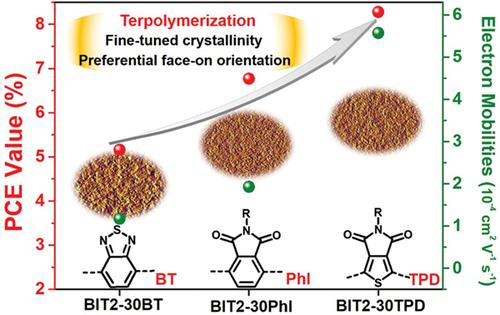Organic Materials Pub Date : 2020-07-16 , DOI: 10.1055/s-0040-1713857 Bin Liu 1, 2, 3 , Huiliang Sun 1 , Chang Woo Koh 4 , Mengyao Su 1 , Bao Tu 1 , Yumin Tang 1 , Qiaogan Liao 1 , Junwei Wang 1 , Wanli Yang 1 , Hong Meng 2 , Han Young Woo 4 , Xugang Guo 1

|
Compared with p-type terpolymers, less effort has been devoted to n-type analogs. Herein, we synthesized a series of n-type terpolymers via incorporating three electron-deficient third components including thienopyrroledione (TPD), phthalimide, and benzothiadiazole into an imide-functionalized parent n-type copolymer to tune optoelectronic properties without sacrificing the n-type characteristics. Due to effects of the third components with different electron-accepting ability and solubility, the resulting three polymers feature distinct energy levels and crystallinity. In addition, heteroatoms (S, O, and N) attached on the third components trigger intramolecular noncovalent interactions, which can increase molecule planarity and have a significant effect on the packing structures of the polymer films. As a result, the best power conversion efficiency of 8.28% was achieved from all-polymer solar cells (all-PSCs) based on n-type terpolymer containing TPD. This is contributed by promoted electron mobility and face-on polymer packing, showing the pronounced advantages of the TPD used as a third component for thriving efficient n-type terpolymers. The generality is also successfully validated in a benchmark polymer donor/acceptor system by introducing TPD into the benchmark n-type polymer N2200. The results demonstrate the feasibility of introducing suitable electron-deficient building blocks as the third components for high-performance n-type terpolymers toward efficient all-PSCs.
中文翻译:

n型三元共聚物中缺电子的第三种成分对全聚合物太阳能电池的形态和性能的影响
与p型三元共聚物相比,n型类似物投入的精力更少。本文中,我们通过将包括噻吩并吡咯二酮(TPD),邻苯二甲酰亚胺和苯并噻二唑的三种缺电子的第三种组分引入酰亚胺官能化的母体n型共聚物中来合成一系列n型三元共聚物,以在不牺牲n型特性的情况下调整光电性能。 。由于具有不同的电子接受能力和溶解性的第三组分的作用,所得的三种聚合物具有不同的能级和结晶度。另外,附着在第三组分上的杂原子(S,O和N)触发分子内非共价相互作用,这可以增加分子平面度并且对聚合物膜的堆积结构具有显着影响。结果是,基于含TPD的n型三元共聚物的全聚合物太阳能电池(all-PSC)的最佳功率转换效率为8.28%。这归因于电子迁移率的提高和面对面的聚合物堆积,显示了TPD用作繁荣高效的n型三元共聚物的第三种成分的显着优势。通过将TPD引入基准n型聚合物N2200中,也可以在基准聚合物供体/受体系统中成功验证通用性。结果证明了向高效的全PSC引入合适的缺电子结构单元作为高性能n型三元共聚物的第三种组分的可行性。这归因于电子迁移率的提高和面对面的聚合物堆积,显示了TPD用作繁荣高效的n型三元共聚物的第三种成分的显着优势。通过将TPD引入基准n型聚合物N2200中,也可以在基准聚合物供体/受体系统中成功验证通用性。结果证明了向高效的全PSC引入合适的缺电子结构单元作为高性能n型三元共聚物的第三种组分的可行性。这归因于电子迁移率的提高和面对面的聚合物堆积,显示了TPD用作繁荣高效的n型三元共聚物的第三种成分的显着优势。通过将TPD引入基准n型聚合物N2200中,也可以在基准聚合物供体/受体系统中成功验证通用性。结果证明了向高效的全PSC引入合适的缺电子结构单元作为高性能n型三元共聚物的第三种组分的可行性。











































 京公网安备 11010802027423号
京公网安备 11010802027423号